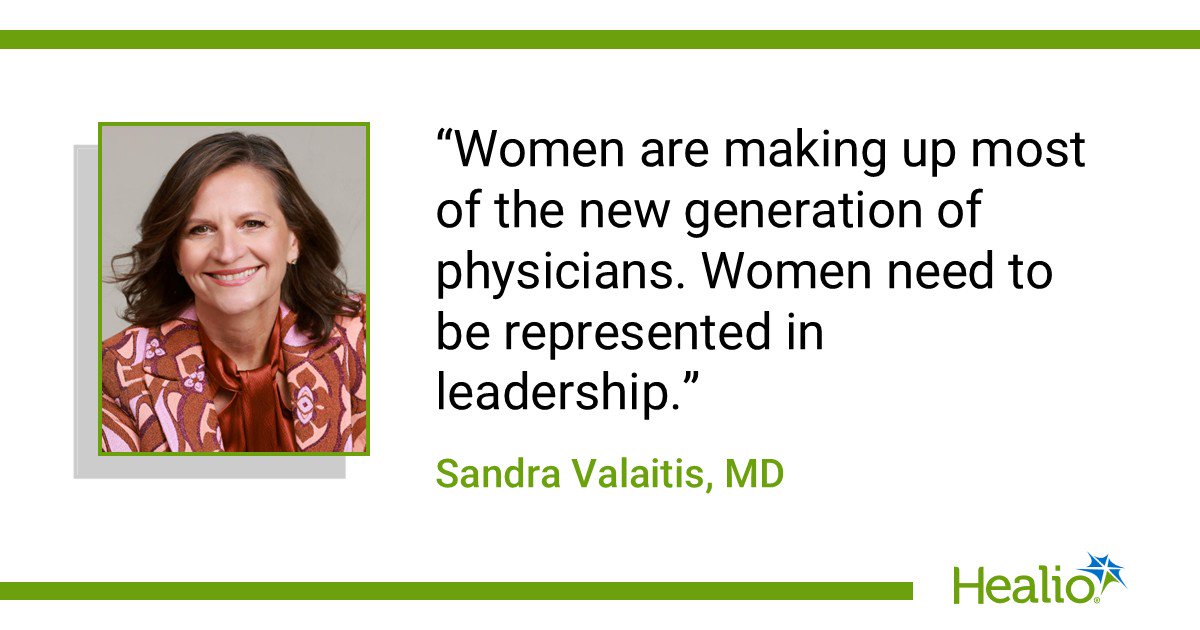September 26, 2025
4 min read
Key takeaways:
- The gender gap in faculty leadership at medical institutions is improving, but still prevalent, according to a speaker.
- Women physicians can take advantage of multiple opportunities to further their career.
CHICAGO — Although women now represent the majority of medical school applicants, leadership positions in academic medicine are disproportionately held by men, highlighting a persistent gender gap between entry and advancement, according to a speaker.
“Women are making up most of the new generation of physicians. Women need to be represented in leadership,” Sandra Valaitis, MD, director of urogynecology at UChicago Medicine AdventHealth Medical Group in Hinsdale, Illinois, and retired professor, vice chair for faculty affairs and chief physician for the AdventHealth partnership with the University of Chicago Medicine, told Healio. “Looking at the data trends, it appears women are catching up, but we still have work to do.”

Valaitis and Annabelle Santos Volgman, MD, the Madeleine and James M. McMullan – Carl E. Eybel, MD, Chair of Excellence in Clinical Cardiology and co-founder and past director of the Rush Heart Center for Women, highlighted gender disparities in academic promotions and how to navigate promotions for women in medicine during a presentation at the Power of Women in Medicine Summit.
Data trends: Women in academic medicine
More than 50% of medical school applications are from women, according to data from the Association of American Medical Colleges (AAMC) The State of the Women in Academic Medicine 2023-2024 report.
Although data show women have assumed more leadership positions in recent years, men hold most of the upper-faculty ranks, Valaitis said.
According to the AAMC report, in 2023 women represented 51% of full-time faculty members aged younger than 50 years. However, this percentage declined for faculty positions held by individuals older than 50 years.
There have been some changes in recent years, according to Volgman’s presentation.
Between 2013 to 2014 and 2022 to 2023, the proportion of full-time women faculty members that were promoted to both associate and full professor per year increased by eight and nine percentage points, respectively, the AAMC’s report found. Over time, the percentage of men promoted to associate professor declined from 61% to 53% and men promoted to full professor declined from 69% to 60%, while the percentage of women promoted to associate professor increased from 39% to 47% and women promoted to full professor increased from 31% to 40%.
In 2023, women held 34% of division or section chief positions — up from 24% in 2013. Similarly, the percentage of women serving as department chairs and deans rose from 15% and 16% in 2023 to 25% and 27% in 2023, respectively, according to the AAMC report. From 2013 to 2023, there were also increases in the percentage of women serving as department chairs (from 15% to 25%) and medical school deans (from 16% to 27%). However, the percentage of women endowed professors falls well below the percentage of men endowed professors (28% vs. 72%).
‘Nothing happens overnight’
There are many factors that contribute to fewer women in leadership positions
In academic medicine, women are rewarded less often with promotable tasks, received less pay for similar work, have higher rates of burnout, are evaluated less favorably, and report experiencing sexual harassment, bullying and bias at greater rates, according to Volgman’s presentation.
“Women may feel more ‘imposter syndrome’ than their male colleagues, especially when it comes to leadership positions and seeking out promotions at higher levels,” Valaitis said. “I think there are a lot of cultural things that play into this, including the roles we take outside of work, making us feel like our focus needs to be elsewhere.”
Valaitis said home and family pressures are also a factor.
“Some female physicians may feel like they cannot afford childcare to pursue leadership roles,” Valaitis said. “As a medical community, creating opportunities for families to have access to childcare through work can be helpful as this option tends to be more affordable than if they were to look elsewhere.”
Valaitis highlighted mentorship as an important step toward faculty promotion, and urged women physicians to seek out a mentor.
“A lot of times as women, we turn to other women for mentorship. But we can also find excellent mentorship with our senior male colleagues, who may have different ways of approaching leadership,” Valaitis said. “Personally, in my life, some of my best mentors were my senior male faculty who took me under their wing and helped me find the path to promotion.”
One way to find a mentor is by volunteering for various committees and activities at your institution, according to Valaitis. By doing this, women physicians will not only increase their exposure among the wider institution faculty but may also discover a passion that could guide their future career.
Valaitis said one of the most important things to do when pursuing a leadership position is to become familiar with an institution’s promotional pathways, as they may differ from other institutions.
“Understand what criteria they are looking for that allows someone to meet their promotion requirements,” Valaitis said. “You should also understand what track you have been hired into and the differences within that track for faculty, in terms of expectations for promotion, required activities and offered benefits.”
Above all, Valaitis encouraged women physicians to be true to themselves as they embark on their career path.
“Be kind to yourself and know that nothing happens overnight,” Valaitis said. “Be kind to others along the way as well, remaining as open as possible to the various possibilities that you may have.”
For more information:
Sandra Valaitis, MD, can be reached at sandra.valaitis.md@adventhealth.com.










